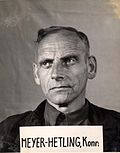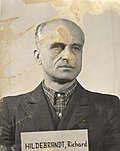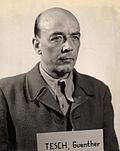
The Nuremberg trials were held by the Allies against representatives of the defeated Nazi Germany, for plotting and carrying out invasions of other countries, and other crimes, in World War II.

Karl Brandt was a German physician and Schutzstaffel (SS) officer in Nazi Germany. Trained in surgery, Brandt joined the Nazi Party in 1932 and became Adolf Hitler's escort doctor in August 1934. A member of Hitler's inner circle at the Berghof, he was selected by Philipp Bouhler, the head of Hitler's Chancellery, to administer the Aktion T4 euthanasia program. Brandt was later appointed the Reich Commissioner of Sanitation and Health. Accused of involvement in human experimentation and other war crimes, Brandt was indicted in late 1946 and faced trial before a U.S. military tribunal along with 22 others in United States of America v. Karl Brandt, et al. He was convicted, sentenced to death, and hanged on 2 June 1948.

Lebensborn e.V. was an SS-initiated, state-supported, registered association in Nazi Germany with the stated goal of increasing the number of children born who met the Nazi standards of "racially pure" and "healthy" Aryans, based on Nazi eugenics. Lebensborn was established by Heinrich Himmler, and provided welfare to its mostly unmarried mothers, encouraged anonymous births by unmarried women at their maternity homes, and mediated adoption of children by likewise "racially pure" and "healthy" parents, particularly SS members and their families. The Cross of Honour of the German Mother was given to the women who bore the most Aryan children. Abortion was legalised by the Nazis for disabled and non-Germanic children, but strictly punished otherwise.

The Doctors' Trial was the first of 12 trials for war crimes of high-ranking German officials and industrialists that the United States authorities held in their occupation zone in Nuremberg, Germany, after the end of World War II. These trials were held before US military courts, not before the International Military Tribunal, but took place in the same rooms at the Palace of Justice. The trials are collectively known as the "subsequent Nuremberg trials", formally the "Trials of War Criminals before the Nuremberg Military Tribunals" (NMT).

The Judges' Trial was the third of the 12 trials for war crimes the U.S. authorities held in their occupation zone in Germany in Nuremberg after the end of World War II. These twelve trials were all held before U.S. military courts, not before the International Military Tribunal, but took place in the same rooms at the Palace of Justice. The twelve U.S. trials are collectively known as the "Subsequent Nuremberg Trials" or, more formally, as the "Trials of War Criminals before the Nuremberg Military Tribunals" (NMT).

The subsequent Nuremberg trials were a series of 12 military tribunals for war crimes against members of the leadership of Nazi Germany between December 1946 and April 1949. They followed the first and best-known Nuremberg trial before the International Military Tribunal which concluded in October 1946. In contrast, the subsequent trials were conducted before U.S. military courts rather than an international court. They are also collectively known as the Nuremberg Military Tribunals.

The Milch Trial was the second of the twelve trials for war crimes the U.S. authorities held in their occupation zone in Germany in Nuremberg after the end of World War II. These twelve trials were all held before U.S. military courts, not before the International Military Tribunal, but took place in the same rooms at the Palace of Justice. The twelve U.S. trials are collectively known as the "Subsequent Nuremberg Trials" or, more formally, as the "Trials of War Criminals before the Nuremberg Military Tribunals" (NMT).

The United States of America vs. Alfried Krupp, et al., commonly known as the Krupp Trial, was the tenth of twelve trials for war crimes that U.S. authorities held in their occupation zone at Nuremberg, Germany after the end of World War II. It concerned the forced labor enterprises of the Krupp concern and other crimes committed by the concern.
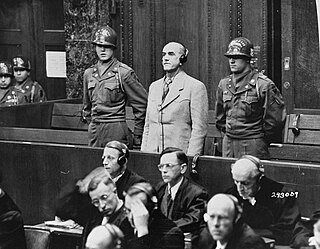
The Pohl Trial against the Nazi German administration of the "Final Solution" was the fourth of the thirteen trials for war crimes that the United States authorities held in their occupation zone in Germany in Nuremberg after the end of World War II. The thirteen trials were all held before U.S. military courts, not before the International Military Tribunal, although both courts presided in the same rooms at the Palace of Justice. They are known collectively as the "Subsequent Nuremberg Trials" or more formally, as the "Trials of War Criminals before the Nuremberg Military Tribunals" (NMT).

The United States of America vs. Friedrich Flick, et al. or Flick Trial was the fifth of twelve Nazi war crimes trials held by United States authorities in their occupation zone in Germany (Nuremberg) after World War II. It was the first of three trials of leading industrialists of Nazi Germany; the two others were the IG Farben Trial and the Krupp Trial.
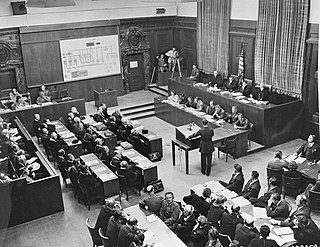
The United States of America vs. Carl Krauch, et al., also known as the IG Farben Trial, was the sixth of the twelve trials for war crimes the U.S. authorities held in their occupation zone in Germany (Nuremberg) after the end of World War II. IG Farben was the private German chemicals company allied with the Nazis that manufactured the Zyklon B gas used to commit genocide against millions of European Jews in the Holocaust.

The Einsatzgruppen Trial was the ninth of the twelve trials for war crimes and crimes against humanity that the US authorities held in their occupation zone in Germany in Nuremberg after the end of World War II. These twelve trials were all held before US military courts, not before the International Military Tribunal. They took place in the same rooms at the Palace of Justice. The twelve US trials are collectively known as the "Subsequent Nuremberg trials" or, more formally, as the "Trials of War Criminals before the Nuremberg Military Tribunals" (NMT).

The High Command Trial, also known initially as Case No. 12, and later as Case No. 72, was the last of the twelve trials for war crimes the U.S. authorities held in their occupation zone of Germany in Nuremberg after the end of World War II. These twelve trials were all held before U.S. military courts, not before the International Military Tribunal, but took place in the same rooms at the Palace of Justice. The twelve U.S. trials are collectively known as the "subsequent Nuremberg trials" or, more formally, as the "Trials of War Criminals before the Nuremberg Military Tribunals" (NMT).

The Ministries Trial was the eleventh of the twelve trials for war crimes the U.S. authorities held in their occupation zone in Germany in Nuremberg after the end of World War II. These twelve trials were all held before U.S. military courts, not before the International Military Tribunal, but took place in the same rooms at the Palace of Justice. The twelve U.S. trials are collectively known as the "Subsequent Nuremberg Trials" or, more formally, as the "Trials of War Criminals before the Nuremberg Military Tribunals" (NMT).
A war crimes trial is the trial of persons charged with criminal violation of the laws and customs of war and related principles of international law committed during armed conflict.

During World War II, around 200,000 ethnic Polish children as well as an unspecified number of children of other ethnicities were abducted from their homes and forcibly transported to Nazi Germany for purposes of forced labour, medical experimentation, or Germanization.

The SS Race and Settlement Main Office was the organization responsible for "safeguarding the racial 'purity' of the SS" within Nazi Germany.

Ulrich Heinrich Emil Richard Greifelt was a German SS functionary and war criminal during the Nazi era. He was convicted at the RuSHA trial at Nuremberg, sentenced to life imprisonment, and died in prison.
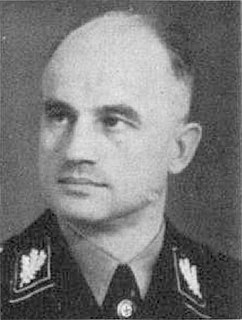
Richard Hermann Hildebrandt was a German Nazi politician and SS-Obergruppenführer. During the Second World War, he served as a Higher SS and Police Leader (HSSPF) in Nazi-occupied Poland, the Soviet Union and the Protectorate of Bohemia and Moravia. He was also the last head of the SS Race and Settlement Main Office in SS headquarters, charged with enforcing Germanization policies. At the end of the war, he was convicted of war crimes and crimes against humanity and was executed. He was the younger brother of Ernst-Albrecht Hildebrandt who was an SS-Oberführer and SS and Police Leader (SSPF) in northern Italy.

Rudolf Creutz was an Austrian Nazi and a high-ranking member of the SS during World War II. He was involved in the implementation of racial resettlement programs in the Occupied Territories and was convicted of war crimes by the Allies in 1948.



